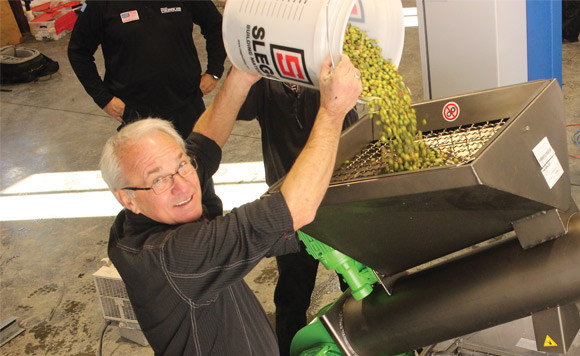Owner / Publisher Sue Hodgson Chats with Sheri and George Braun, Owners of The Olive Farm on Salt Spring Island
There are very few locations in Canada that could even begin to provide the growing needs for good quality and high quantities of olive fruit. What makes Salt Spring Island a desirable place to launch your business, and what have been some of the difficulties in doing so in this area?
When we finally decided on growing olives right here in Canada, we started off looking for a location with a mild winter climate, along with a long warm summer. This search naturally drew us to the west coast of Canada and more specifically to the Gulf Islands. We had decided early on that Salt Spring Island was the place for us to start this grand experiment, so after a few years of looking we finally found what we thought was the perfect place, here on the south end of Salt Spring on a south-sloping, reasonably well-draining hillside that would provide our trees with long sunny days during the spring, summer and fall months. Winter, and early spring with all the rain, have been a challenge, but we did our best to help the trees manage with all the rain by installing a few thousand feet of field drains to reduce the amount of moisture in the hillside. Also, the record cold winter we had last year proved a bit too much for some of our trees, as we had a lot of frost damage to the ends of the branches. We have since pruned them out and it appears that with just a few exceptions, the trees have all come back with vigorous new growth.
You both lived most of your lives in Alberta, George as a railway construction manager and Sheri in education and counselling. What made you decide to leave Alberta and make your way west to Vancouver Island?
Well, let me start off by saying that both Sheri and I grew up in Abbotsford, B.C. And Sheri’s mother was born and raised on Salt Spring Island, so coming back to B.C. was an easy choice for us. Don’t get me wrong, Alberta is a great place; we spent 25 years there. Raised our family, grew our business and made lifelong friends that we still stay in touch with. But as things go, the company sold. Our son moved east to Ottawa and our daughter moved west to Langley, B.C.
With 73 acres and 2,500 producing olive trees, you planted your first grove of 1,000 trees in 2012. What varieties of trees were considered, and when was your first harvest?
Our farm is situated on 72 acres, with 1,000 six-year-old trees that are just starting to produce some fruit. The initial grove was planted in 2012 with approximately 300 Leccino, 300 Frantoio, 300 Maurino and about 100 Pendolino. These trees are all considered to be cold, hardy varieties that should have a reasonable chance of surviving here in our climate. We planted an additional 500 olive trees in 2014 which are a combination of Picual, Bosana, Carolea, Grignan, Picholine and Nocellara de Belice. Then in 2015 we planted another 1,000 Allegra. This will give us approximately 2,500 trees for future harvests.
Olive trees take a long time to mature and produce fruit, especially the large quantity of fruit necessary to press oil. How did you fill the years between planting and harvest?
When we bought the farm, there was an existing vineyard, which we have just removed this past year. It had an acre of newly planted blueberries and then we planted 200 cherry trees which just started producing last year. So, between tending the olive trees, blueberries, grapevines and cherries, we have had enough to fill our days.
What does it take to be an olive grower, and compared to other fruit farming, what are some challenges unique to growing olives?
To be an olive grower here, I think you must approach it knowing that you are growing beyond the edge of where this tree is typically grown and therefore realize that you may or may not be successful; it’s a high-risk crop. I think it’s like the way West Coast wineries started out years ago, with everyone telling them it wouldn’t work. It’s too wet, not enough heat, not enough sunshine hours and so on. But like every new endeavor, there will be some success along with some failures. So, the real challenge is to find the right piece of land and the right olive varietal that will adapt to our climate; that’s what we’re trying to figure out as we plant the different varieties.
The best olive oils are difficult to find, but it’s worth the search! Fresh high quality olive oils contain more nutrients and will provide far more health benefits than this liquid gold is even known for. How does The Olive Farm’s olive oil compare to some of the award-winning oils found around the world?
You are so right and it is unfortunate that so much of the high-quality olive oil is bought up long before it hits the supermarket shelves. Our 100% Canadian Extra Virgin Olive Oil has polyphenols reading as high as 615 with peroxide values as low as 0.05, which really means it has great antioxidant qualities along with a long shelf life, although you should try to use your oil with the first 12 to 18 months after milling to obtain the best nutritional value from it. We have had our oil tasted by olive oil sommeliers and some of Canada’s top chefs and they have all expressed their delight with our product! Their comments have ranged from exceptional, amazing and unique; with flavour profiles including everything from endives to seaweed; and with a buttery complex taste but not greasy, with a peppery finish. Some have compared our EVOO to the oils of northern Italy.
The Olive Farm grove is now 2,500 trees strong, and weather dependent, you expect the next harvest to take place this December, resulting in 2017 pressing to ship mid-February 2018. What’s next for the olive farm, and where can we expect to find your 100 percent Canadian Extra Virgin Olive Oil?
Hopefully we can get a long and extended fall for the fruit to ripen and then yes, we will be harvesting and milling in late November or early December. Bottling will occur some six to eight weeks later, allowing the oil to settle out a bit. To date we have been selling some of our oil directly to the restaurant community, with all other sales online through our website.
As for what’s next? We’re planning to expand our operations by planting more trees, thus ensuring more production for our future, which in turn would allow us to open a store right on the farm for direct customer sales, along with farm tours and a few other things that are just in the idea stages.
For more information visit www.theolivefarm.ca. Photo by Sean McIntyre.




